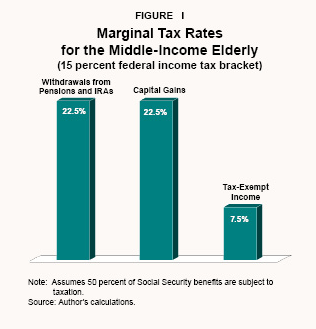The Social Security benefits tax – while nominally a tax on Social Security benefits – is really a tax on other retirement income like pensions or personal savings. And it inflicts some of the highest marginal tax rates in the entire federal tax code.
How Benefits Are Taxed. The federal government imposes taxes on up to half the benefits of single retirees with modified adjusted gross incomes higher than $25,000, and couples with incomes above $32,000. Affected retirees must add 50 cents in benefits to their taxable income for every dollar of income above the threshold until half their benefits are subject to the income tax. Thus, when these retirees receive $1.00 of income, they must pay taxes on $1.50. As a result, their marginal tax rate is 50 percent higher than for young people with the same income.

As income rises, the tax becomes more onerous. Single retirees with incomes above $34,000 and couples with incomes higher than $44,000 must add 85 cents in benefits to taxable income for every dollar of income above these thresholds until 85 percent of their benefits are taxed. Thus, when these retirees receive $1.00, they must pay taxes on $1.85. As a result, their marginal tax rate is 85 percent higher than for young people with the same income.
Who Pays the Tax? The Social Security benefits tax affected less than one in 10 beneficiaries when it was first imposed. Today, however, it affects more than one of every five recipients. By the time the children of the baby boomers retire, almost all beneficiaries will be paying tax on some portion of their benefits. Why? Because the thresholds at which the benefits tax is triggered are not adjusted for inflation, and more and more people will be subject to the tax as incomes rise over time.
Taxing Savings. About 60 percent of the income of elderly taxpayers comes from investments – including pensions, Individual Retirement Accounts (IRAs) and 401(k)s. For most workers, the tax rate on investment income is 15 percent or 25 percent. For the elderly, the Social Security benefits tax makes the effective rate much higher:
- Elderly taxpayers in the 15 percent income tax bracket – and subject to the 50 percent benefits tax – pay an effective rate of 22.5 percent (15 percent x 1.50).
- Elderly taxpayers in the 25 percent tax bracket – and subject to the 85 percent benefits tax – pay an effective rate of 46.25 percent (25 percent x 1.85).
Taxing Wages. Because of the so-called earnings test, the benefits tax severely penalizes moderate-income elderly who collect early retirement benefits from Social Security and continue to receive wage income. In 2006, Social Security will withhold $1 of these workers' benefits for every $2 of non-Social Security wages in excess of $12,480. When a worker loses benefits in a period, he gets credit for a later retirement, which restores some of the benefits later in life (if he lives long enough). Still, most workers see the earnings test as a tax that discourages effort.

Consider a self-employed worker who retires early at age 62, but discovers he must return to work part-time to pay the bills. His earned income plus one-half of his Social Security benefits equals $30,000. If he earns one additional dollar, he loses 50 cents of benefits to the earnings test, and his other taxes – ordinary income, payroll and benefits taxes – approach 35 percent (after all interactions), resulting in take-home pay of only 15 cents on the dollar. His marginal tax rate is nearly 85 percent. Now imagine this worker's wage income is above the $34,000 threshold mentioned earlier, such that 85 cents of his Social Security benefits are subject to taxation for each additional dollar he earns. His effective federal marginal tax rate is 105 percent!
Additionally, many states accept the federal definition of taxable income; thus, the Social Security benefits tax increases some state and local income tax rates by 50 percent to 85 percent, depending on the income level, raising the total effective tax rate even higher.
Effects of the Benefits Tax. Consider the effect on a single retiree in the 15 percent tax bracket with a post-retirement income above the first benefits tax threshold, where 50 percent of benefits are subject to taxation. [See Figure I.]
- This retiree could be taxed at a rate of 7.5 percent on traditionally tax-exempt income (such as interest on municipal bonds) whereas younger taxpayers would pay a zero tax rate.
- Withdrawals from pension accounts and capital gains income would be taxed at a 22.5 percent rate versus 15 percent for others.
Consider further the effects on a single retiree in the 25 percent tax bracket whose total income is above the second Social Security benefits tax threshold. As Figure II shows:
- Tax-exempt income can be taxed at a rate of 21.25 percent versus a zero rate for younger taxpayers.
- Capital gains income issubject to a 36.25 percent rate versus 15 percent for others.
- Withdrawals from pension accounts are subject to a 46.25 percent rate versus 25 percent for others.
In fact, a middle-income couple living on IRA withdrawals can face a higher marginal tax rate than Warren Buffet or Bill Gates.
Solution: Remove Social Security's Penalties on Work. To eliminate the odd effects of the Social Security benefits tax, Congress should repeal it. If there is an argument for taxing these benefits, the correct way to tax them is to include a portion of them in ordinary income and subject them to ordinary income tax rates. Middle-income seniors would pay taxes on some portion of their Social Security benefits the same way they pay taxes on IRA withdrawals and pension benefits – at the same tax rate faced by younger taxpayers.
Stephen J. Entin is president and executive director of the Institute for Research on the Economics of Taxation in Washington, D.C.